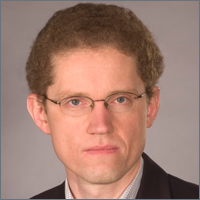
Darius Kuciauskas
Researcher V-Chemistry
Darius.Kuciauskas@nrel.gov
303-384-6572
 https://orcid.org/0000-0001-8091-5718
https://orcid.org/0000-0001-8091-5718
Dr. Kuciauskas is a senior scientist in a Spectroscopy and Photoscience group, where he works on electro-optical characterization of photovoltaic (PV) and electronic materials and devices. His laboratory includes two femtosecond laser systems, low-temperature and time-resolved photoluminescence spectrometers, and a microscope for time-resolved correlative optical measurements. Research is supported by the DOE EERE SunShot projects on increasing the efficiency and reliability of PV solar cells. We actively collaborate within NREL, with university PV groups and the PV industry. Dr. Kuciauskas has authored or co-authored more than 100 peer-reviewed publications in applied physics, materials science, photovoltaics, and physical chemistry.
Research Interests
- Technique development for spectroscopic and microscopic electro-optical characterization
- Defect analysis in semiconductors and devices
- Metastability and degradation analysis in solar cells
- Characterization of semiconductor passivation and doping
- CdTe, CIGS, kesterites, perovskites, and other PV materials and solar cells
Education
Postdoctoral Scholar, California Institute of Technology
Ph.D. Chemistry, Arizona State University
Diploma Physics, Vilnius University
Featured Work
Kuciauskas et al., “Time-resolved correlative optical microscopy of charge-carrier transport, recombination, and space-charge fields in CdTe heterostructures,” Appl. Phys. Lett. 110, 83905 (2017), DOI: 10.1063/1.4976696
Kuciauskas et al., “The impact of Cu on recombination in high voltage CdTe solar cells,” Appl. Phys. Lett. 107, 243906 (2015), DOI: 10.1063/1.4938127
Kuciauskas et al., “Charge-carrier dynamics in polycrystalline thin-film CuIn1−xGaxSe2 photovoltaic devices after pulsed laser excitation: Interface and space-charge region analysis,” J. Appl. Phys. 117, 185102 (2015), DOI: 10.1063/1.4921011
Ma, Kuciauskas, et al., “Dependence of the minority-carrier lifetime on the stoichiometry of CdTe using time-resolved photoluminescence and first-principles calculations,” Phys. Rev. Lett. 111, 67402 (2013), DOI: 10.1103/PhysRevLett.111.067402
Share

